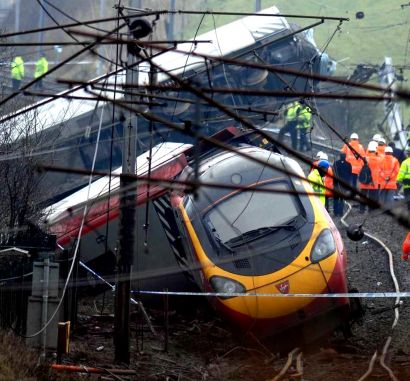A FAILURE to properly maintain and check a set of faulty points led to the derailment of a Pendolino train travelling at 95mph on the West Coast route in Cumbria, a full report into the crash confirms.
An 84-year-old woman died and 86 were injured – 28 seriously – after the Virgin Trains express heading for Glasgow derailed at the Lambrigg emergency crossover near to the village of Grayrigg, the carriages careering down an embankment.
The 225-page report blames lack of maintenance at 2B points which it says were in an unsafe state due to a combination of failures of stretcher bars and their joint to the switch rails.
The report by the Rail Accident Investigation Branch says the situation arose because of failures in the mechanism of the points, the points being incorrectly set up and the omission of a scheduled weekly inspection on 18 February – five days before the train derailed at 20.12 hours on 23 February.
Three stretcher bars keep the moving point blades the correct distance apart but bolts on number one stretcher bar and the lock stretcher started to vibrate loose and then the stretcher bar broke.
This was followed by the bolts on the lock stretcher bar vibrating right off and the right hand switch blade acting independently without being fastened. The wheels of the leading vehicle then ‘climbed’ over the points.
The RAIB report comes just over a year since the publication of the industry investigation into the crash, the first involving a Pendolino.
At that time the report said a catalogue of failings in the track inspection and maintenance regime of Network Rail’s Lancashire and Cumbria area led to the crash.
The failings, including a ‘them and us’ situation between management and supervisors over training and track access issues, led to the points not being inspected properly.
Mechanical issues relating to the failure of the points had started nearly three months before the crash.
At one stage vital nuts had already been found to be missing on the number three stretcher bar of points 2B on 7 January by a patrol. The nuts were replaced.
The new RAIB report says that deterioration of parts of the points took place over a period at least 11 days before the accident.
An inspection, scheduled for 18 February, which should have detected the degradation never happened.
“There were a number of shortcomings in Network Rail’s safety management arrangements which were underlying factors in this accident,” says the report.
In a statement issued after publication of the latest report, Iain Coucher, chief executive of Network Rail, said that 32 of the 33 recommendations and actions to come from the industry report had been carried out to prevent such an accident in the future.
He said: “The tragedy at Grayrigg was caused by the failure of our infrastructure, something we were devastated to discover. We immediately accepted responsibility for the accident and one again we apologise today to Mrs Masson’s family and all those affected.”
Mr Coucher said Network Rail had worked with the RAIB to provide evidence for the new report. “Our task now is to review RAIB’s findings together with the national safety authority – the Office of Rail Regulation – to see if there is more that can be done.”
Some of the actions and recommendations which have been made since the accident include:
• The Lambrigg points have been removed and will not be replaced
• Checks have been made on almost 1,500 sets of points nationwide with nothing out of the ordinary found
• A new special self-locking nut has been introduced into points assemblies across the country to further improve this very robust design
• Specialist ‘points’ squads have been created within the maintenance function
• Inspection, audit and assurance improvements have been made and changes to the organisation structure implemented.
•
Network Rail added that the company estimated three trillion train movements had taken place safely without incident over points of the same design and fixed stretcher bar points were a well proven and very robust design.
The RAIB report adds that Network Rail has embarked on a programme of rectification of ‘residual switch openings’ starting with what it perceives as its highest risk points. This is still in progress.
It has also started the analysis of the loads and forces placed upon its non-adjustable stretcher bar assemblies so that it can review the design and if necessary upgrade them.
Meanwhile, Network Rail has responded to a national newspaper article which said that the company had appealed against an improvement notice issued by the Office of Rail Regulation calling for action on the issue of points degradation.
The company said: “We can confirm that we have appealed against an ORR improvement notice related to the design of fixed stretcher bar points.
“The notice is presently suspended as we demonstrate the overwhelming evidence in our possession which shows the robustness of a design that has been in use in the UK and across Europe since the 1940s and has an almost exemplary safety record.
“Lessons from Grayrigg led us to make some alterations to further improve the design with the installation of a new ‘locking’ nut and bolt assembly.”
For full report please click on link and download pdf RAIB Report
Grayrigg crash points were left in ‘unsafe’ condition, says official report
23rd October 2008


